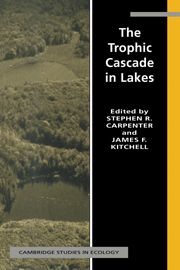Book contents
- Frontmatter
- Contents
- Contributors
- Preface
- 1 Cascading trophic interactions
- 2 Experimental lakes, manipulations and measurements
- 3 Statistical analysis of the ecosystem experiments
- 4 The fish populations
- 5 Fish behavioral and community responses to manipulation
- 6 Roles of fish predation: piscivory and planktivory
- 7 Dynamics of the phantom midge: implications for zooplankton
- 8 Zooplankton community dynamics
- 9 Effects of predators and food supply on diel vertical migration of Daphnia
- 10 Zooplankton biomass and body size
- 11 Phytoplankton community dynamics
- 12 Metalimnetic phytoplankton dynamics
- 13 Primary production and its interactions with nutrients and light transmission
- 14 Heterotrophic microbial processes
- 15 Annual fossil records of food-web manipulation
- 16 Simulation models of the trophic cascade: predictions and evaluations
- 17 Synthesis and new directions
- References
- Index
13 - Primary production and its interactions with nutrients and light transmission
Published online by Cambridge University Press: 06 August 2010
- Frontmatter
- Contents
- Contributors
- Preface
- 1 Cascading trophic interactions
- 2 Experimental lakes, manipulations and measurements
- 3 Statistical analysis of the ecosystem experiments
- 4 The fish populations
- 5 Fish behavioral and community responses to manipulation
- 6 Roles of fish predation: piscivory and planktivory
- 7 Dynamics of the phantom midge: implications for zooplankton
- 8 Zooplankton community dynamics
- 9 Effects of predators and food supply on diel vertical migration of Daphnia
- 10 Zooplankton biomass and body size
- 11 Phytoplankton community dynamics
- 12 Metalimnetic phytoplankton dynamics
- 13 Primary production and its interactions with nutrients and light transmission
- 14 Heterotrophic microbial processes
- 15 Annual fossil records of food-web manipulation
- 16 Simulation models of the trophic cascade: predictions and evaluations
- 17 Synthesis and new directions
- References
- Index
Summary
Introduction
The trophic cascade from fish to ecosystem processes is the central theme of this book. Previous chapters have documented the changes in piscivore, planktivore and herbivore trophic levels in our experimental lakes. Effects of changes in herbivory on phytoplankton communities have been discussed (Chapter 11) and we have compared the distinctive habitats for algae provided by the epilimnion and metalimnion (Chapter 12). This chapter turns to the central ecosystem variates of our study: biomass and metabolism of primary producers.
In lakes, dynamics of herbivores, primary producers nutrients, and light have strong feedbacks. Excretion by herbivores is a major source of nutrients for phytoplankton. Limnetic grazers affect their prey negatively, through grazing, and positively, through nutrient recycling. The phytoplankton also respond to inputs of nutrients from outside the lake, and to mixing of nutrients upward from the hypolimnion. Light drives photosynthesis, and phytoplankton attenuate light as it passes down-ward through the water column. In lakes where substantial aggregations of algae exist in deep, low-light habitats, feedbacks between algal biomass and light extinction may strongly influence primary production (Chapter 12).
These strong feedbacks imply that primary production cannot be addressed without considering physical–chemical factors such as mixing depth, irradiance, and nutrient limitation. This chapter focuses on dynamics of algal biomass (measured as chlorophyll) and production, in the context of selected physical and chemical characteristics of the water column. These include indicators of nutrient deficiency, light penetration, and mixing depth.
- Type
- Chapter
- Information
- The Trophic Cascade in Lakes , pp. 225 - 251Publisher: Cambridge University PressPrint publication year: 1993
- 2
- Cited by



